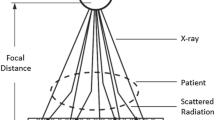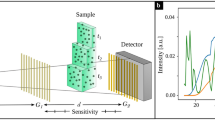Abstract
Digital breast tomosynthesis (DBT) is an imaging modality in which tomographic sections of the breast are generated from a limited range of x-ray tube angles. One drawback of DBT is resolution loss in the oblique projection images. The purpose of this work is to extend Swank’s formulation of the transfer functions of turbid granular phosphors to oblique x-ray incidence, using the diffusion approximation to the Boltzmann equation to model the spread of light in the phosphor. As expected, the modulation transfer function (MTF) and noise power spectra (NPS) are found to decrease with projection angle regardless of frequency. By contrast, the dependence of detective quantum efficiency (DQE) on projection angle is frequency dependent. DQE increases with projection angle at low frequencies, and only decreases with projection angle at high frequencies. Importantly, the x-ray quantum detection efficiency (A Q) and the Swank information factor (A S) are also found to be angularly dependent.
Access this chapter
Tax calculation will be finalised at checkout
Purchases are for personal use only
Preview
Unable to display preview. Download preview PDF.
Similar content being viewed by others
References
Rafferty, E.: Tomosynthesis: New Weapon in Breast Cancer Fight. Imaging Economics 17(4) (2004)
Mainprize, J.G., Bloomquist, A.K., Kempston, M.P., Yaffe, M.J.: Resolution at oblique incidence angles of a flat panel imager for breast tomosynthesis. Med. Phys. 33(9), 3159–3164 (2006)
Hajdok, G., Cunningham, I.A.: Penalty on the detective quantum efficiency from off-axis incident x rays. In: Yaffe, M.J., Flynn, M.J. (eds.) Proc. of SPIE, Medical Imaging 2004: Physics of Medical Imaging, vol. 5368, pp. 109–118. SPIE, Bellingham (2004)
Swank, R.K.: Calculation of Modulation Transfer Functions of X-Ray Fluorescent Screens. Appl. Opt. 12(8), 1865–1870 (1973)
Marshak, R.E., Brooks, H., Hurwitz Jr., H.: Introduction to the Theory of Diffusion and Slowing Down of Neutrons – I. Nucleonics 4, 10–22 (1949)
Nishikawa, R.M., Yaffe, M.J.: Model of the spatial-frequency-dependent detective quantum efficiency of phosphor screens. Med. Phys. 17(5), 894–904 (1990)
Nishikawa, R.M., Yaffe, M.J.: Effect of various noise sources on the detective quantum efficiency of phosphor screens. Med. Phys. 17(5), 887–893 (1990)
Swank, R.K.: Absorption and noise in x-ray phosphors. J. Appl. Phys. 44(9), 4199–4203 (1973)
Badano, A., Kyprianou, I.S., Sempau, J.: Anisotropic imaging performance in indirect x-ray imaging detectors. Med. Phys. 33(8), 2698–2713 (2006)
Author information
Authors and Affiliations
Editor information
Editors and Affiliations
Rights and permissions
Copyright information
© 2010 Springer-Verlag Berlin Heidelberg
About this paper
Cite this paper
Acciavatti, R.J., Maidment, A.D.A. (2010). Calculation of OTF, NPS, and DQE for Oblique X-Ray Incidence on Turbid Granular Phosphors. In: Martí, J., Oliver, A., Freixenet, J., Martí, R. (eds) Digital Mammography. IWDM 2010. Lecture Notes in Computer Science, vol 6136. Springer, Berlin, Heidelberg. https://doi.org/10.1007/978-3-642-13666-5_59
Download citation
DOI: https://doi.org/10.1007/978-3-642-13666-5_59
Publisher Name: Springer, Berlin, Heidelberg
Print ISBN: 978-3-642-13665-8
Online ISBN: 978-3-642-13666-5
eBook Packages: Computer ScienceComputer Science (R0)




